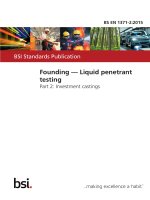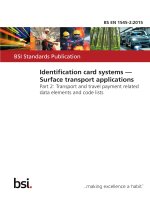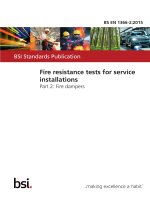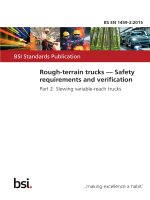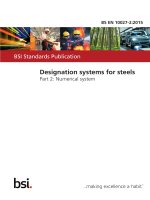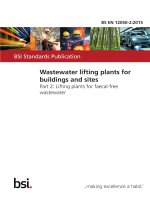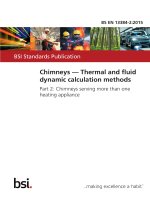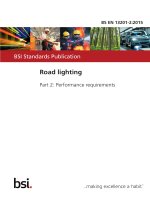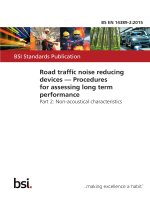Bsi bs en 00556 2 2015
Bạn đang xem bản rút gọn của tài liệu. Xem và tải ngay bản đầy đủ của tài liệu tại đây (1.01 MB, 20 trang )
BS EN 556-2:2015
BSI Standards Publication
Sterilization of medical devices
— Requirements for medical
devices to be designated
''STERILE"
Part 2: Requirements for aseptically
processed medical devices
BS EN 556-2:2015
BRITISH STANDARD
National foreword
This British Standard is the UK implementation of EN 556-2:2015. It
supersedes BS EN 556-2:2003 which is withdrawn.
The UK participation in its preparation was entrusted to Technical
Committee CH/198, Sterilization and Associated Equipment and
Processes.
A list of organizations represented on this committee can be
obtained on request to its secretary.
This publication does not purport to include all the necessary
provisions of a contract. Users are responsible for its correct
application.
© The British Standards Institution 2015. Published by BSI Standards
Limited 2015
ISBN 978 0 580 80961 3
ICS 11.080.01
Compliance with a British Standard cannot confer immunity from
legal obligations.
This British Standard was published under the authority of the
Standards Policy and Strategy Committee on 30 September 2015.
Amendments issued since publication
Date
Text affected
BS EN 556-2:2015
EN 556-2
EUROPEAN STANDARD
NORME EUROPÉENNE
EUROPÄISCHE NORM
September 2015
ICS 11.080.01
Supersedes EN 556-2:2003
English Version
Sterilization of medical devices - Requirements for medical
devices to be designated ''STERILE" - Part 2: Requirements
for aseptically processed medical devices
Stérilisation des dispositifs médicaux - Exigences
relatives aux dispositifs médicaux en vue d'obtenir
l'étiquetage " STÉRILE " - Partie 2 : Exigences pour les
dispositifs médicaux soumis à un traitement aseptique
Sterilisation von Medizinprodukten - Anforderungen
an Medizinprodukte, die als ''STERIL'' gekennzeichnet
werden - Teil 2: Anforderungen an aseptisch
hergestellte Medizinprodukte
This European Standard was approved by CEN on 24 July 2015.
CEN members are bound to comply with the CEN/CENELEC Internal Regulations which stipulate the conditions for giving this
European Standard the status of a national standard without any alteration. Up-to-date lists and bibliographical references
concerning such national standards may be obtained on application to the CEN-CENELEC Management Centre or to any CEN
member.
This European Standard exists in three official versions (English, French, German). A version in any other language made by
translation under the responsibility of a CEN member into its own language and notified to the CEN-CENELEC Management
Centre has the same status as the official versions.
CEN members are the national standards bodies of Austria, Belgium, Bulgaria, Croatia, Cyprus, Czech Republic, Denmark, Estonia,
Finland, Former Yugoslav Republic of Macedonia, France, Germany, Greece, Hungary, Iceland, Ireland, Italy, Latvia, Lithuania,
Luxembourg, Malta, Netherlands, Norway, Poland, Portugal, Romania, Slovakia, Slovenia, Spain, Sweden, Switzerland, Turkey and
United Kingdom.
EUROPEAN COMMITTEE FOR STANDARDIZATION
COMITÉ EUROPÉEN DE NORMALISATION
EUROPÄISCHES KOMITEE FÜR NORMUNG
CEN-CENELEC Management Centre: Avenue Marnix 17, B-1000 Brussels
© 2015 CEN
All rights of exploitation in any form and by any means reserved
worldwide for CEN national Members.
Ref. No. EN 556-2:2015 E
BS EN 556-2:2015
EN 556-2:2015 (E)
Contents
Page
European foreword ................................................................................................................................................................ 3
Introduction.............................................................................................................................................................................. 4
1
Scope ............................................................................................................................................................................. 5
2
Normative references ............................................................................................................................................. 5
3
Terms and definitions............................................................................................................................................. 6
4
4.1
4.2
4.3
Requirements ............................................................................................................................................................ 8
Validation and routine control ............................................................................................................................ 8
Compliance .............................................................................................................................................................. 10
Documentation and records .............................................................................................................................. 10
Annex ZA (informative) Relationship between this European Standard and the Essential
Requirements of EU Directive 90/385/EEC on active implantable medical devices.................... 11
Annex ZB (informative) Relationship between this European Standard and the Essential
Requirements of EU Directive 93/42/EEC on medical devices............................................................. 12
Annex ZC (informative) Relationship between this European Standard and the Essential
Requirements of EU Directive 98/79/EC on in vitro diagnostic medical devices .......................... 13
Bibliography .......................................................................................................................................................................... 15
2
BS EN 556-2:2015
EN 556-2:2015 (E)
European foreword
This document (EN 556-2:2015) has been prepared by Technical Committee CEN/TC 204 “Sterilization of
medical devices”, the secretariat of which is held by BSI.
This European Standard shall be given the status of a national standard, either by publication of an
identical text or by endorsement, at the latest by March 2016, and conflicting national standards shall be
withdrawn at the latest by March 2016.
Attention is drawn to the possibility that some of the elements of this document may be the subject of
patent rights. CEN [and/or CENELEC] shall not be held responsible for identifying any or all such patent
rights.
This document supersedes EN 556-2:2003.
This document has been prepared under a mandate given to CEN by the European Commission and the
European Free Trade Association, and supports essential requirements of EU Directive(s).
For relationship with EU Directive(s), see informative Annexes ZA, ZB and ZC, which are integral parts of
this document.
EN 556, Sterilization of medical devices — Requirements for medical devices to be designated ''STERILE", is
currently composed with the following parts:
— Part 1: Requirements for terminally sterilized medical devices;
— Part 2: Requirements for aseptically processed medical devices [this document].
The following amendments have been made in updating the document from EN 556-2:2003:
a) normative references have been updated;
b) terms and definitions have been aligned with ISO/TS 11139 and EN ISO 13408-1;
c) requirements on validation and routine control have been revised;
d) Table 1 and Table 2 on acceptance limits and actions for occurrence of non-sterile units in process
simulations in initial performance qualification and in periodic requalification, respectively, have
been added;
e) editorial revision according to the CEN Internal Regulations.
Annexes designated ‘informative’ are given only for information. In this standard Annexes ZA, ZB and ZC
are informative.
According to the CEN-CENELEC Internal Regulations, the national standards organizations of the
following countries are bound to implement this European Standard: Austria, Belgium, Bulgaria, Croatia,
Cyprus, Czech Republic, Denmark, Estonia, Finland, Former Yugoslav Republic of Macedonia, France,
Germany, Greece, Hungary, Iceland, Ireland, Italy, Latvia, Lithuania, Luxembourg, Malta, Netherlands,
Norway, Poland, Portugal, Romania, Slovakia, Slovenia, Spain, Sweden, Switzerland, Turkey and the
United Kingdom.
3
BS EN 556-2:2015
EN 556-2:2015 (E)
Introduction
Medical devices designated 'STERILE' are prepared using appropriate and validated methods. Whenever
possible, sterile medical devices are terminally-sterilized using a properly validated and controlled
sterilization process (see EN 556-1, EN ISO 11135, EN ISO 11137-1, EN ISO 14160, EN ISO 14937,
EN ISO 17665-1, EN ISO 20857 and EN ISO 25424). When a medical device is intended to be sterile but
cannot be terminally-sterilized, aseptic processing is the method of manufacture (see EN ISO 13408-1).
Aseptic processing necessitates that either:
a) the entire product is sterilized and then introduced into a sterilized package; or
b) components of the product are sterilized, then further processed/assembled, and the final product
packed into a sterilized package.
Processing/assembly and packaging are carried out in a manner that minimizes the opportunity for items
to become re-contaminated by carrying out these operations in a controlled environment in which
microbial and particulate levels are maintained at or below defined limits and human intervention is
minimized.
NOTE
4
EN ISO 15223-1 specifies the label applied to aseptically processed medical devices as STERILE A.
BS EN 556-2:2015
EN 556-2:2015 (E)
1 Scope
This European Standard specifies the requirements for an aseptically processed medical device to be
designated 'STERILE'.
NOTE
For the purpose of the EU Directive(s) for medical devices (see Bibliography), designating that a medical
device is 'STERILE' is permissible when a validated manufacturing and sterilization process has been applied.
Requirements for validation and routine control of aseptic processes are specified in EN ISO 13408-1. Specific
requirements for the aseptic processing of solid medical devices and combination products are specified in
ISO 13408-7.
2 Normative references
The following documents, in whole or in part, are normatively referenced in this document and are
indispensable for its application. For dated references, only the edition cited applies. For undated
references, the latest edition of the referenced document (including any amendments) applies.
EN ISO 11135:2014, Sterilization of health-care products — Ethylene oxide — Requirements for the
development, validation and routine control of a sterilization process for medical devices (ISO 11135:2014)
EN ISO 11137-1:2015, Sterilization of health care products — Radiation — Part 1: Requirements for
development, validation and routine control of a sterilization process for medical devices (ISO 111371:2006, including Amd 1:2013)
EN ISO 13408-2:2011, Aseptic processing of health care products — Part 2: Filtration (ISO 13408-2:2003)
EN ISO 13408-5:2011, Aseptic processing of health care products — Part 5: Sterilization in place
(ISO 13408-5:2006)
EN ISO 13485:2012, Medical devices — Quality management systems — Requirements for regulatory
purposes (ISO 13485:2003)
EN ISO 14160:2011, Sterilization of health care products — Liquid chemical sterilizing agents for single-use
medical devices utilizing animal tissues and their derivatives — Requirements for characterization,
development, validation and routine control of a sterilization process for medical devices (ISO 14160:2011)
EN ISO 14937:2009, Sterilization of health care products — General requirements for characterization of a
sterilizing agent and the development, validation and routine control of a sterilization process for medical
devices (ISO 14937:2009)
EN ISO 17665-1:2006, Sterilization of health care products — Moist heat — Part 1: Requirements for the
development, validation and routine control of a sterilization process for medical devices
(ISO 17665-1:2006)
EN ISO 20857:2013, Sterilization of health care products — Dry heat — Requirements for the development,
validation and routine control of a sterilization process for medical devices (ISO 20857:2010)
EN ISO 25424:2011, Sterilization of medical devices — Low temperature steam and formaldehyde —
Requirements for development, validation and routine control of a sterilization process for medical devices
(ISO 25424:2009)
5
BS EN 556-2:2015
EN 556-2:2015 (E)
3 Terms and definitions
For the purposes of this document, the following terms and definitions apply.
3.1
aseptic processing
handling of sterile product, containers and/or devices in a controlled environment, in which the air
supply, materials, equipment and personnel are regulated to maintain sterility
[SOURCE: EN ISO 13408-1:2015, 3.4]
3.2
bioburden
population of viable microorganisms on or in product and/or sterile barrier system
[SOURCE: ISO/TS 11139:2006, 2.2]
3.3
medical device
instrument, apparatus, implement, machine, appliance, implant, in vitro reagent or calibrator, software,
material or other similar or related article, intended by the manufacturer to be used, alone or in
combination, for human beings for one or more of the specific purpose(s) of:
— diagnosis, prevention, monitoring, treatment or alleviation of disease,
— diagnosis, monitoring, treatment, alleviation of or compensation for an injury,
— investigation, replacement, modification or support of the anatomy or of a physiological process,
— supporting or sustaining life,
— control of conception,
— disinfection of medical devices,
— providing information for medical purposes by means of in vitro examination of specimens derived
from the human body
and which does not achieve its primary intended action in or on the human body by pharmacological,
immunological or metabolic means, but which may be assisted in its function by such means
[SOURCE: EN ISO 13485:2012, 3.7]
3.4
performance qualification
PQ
process of obtaining and documenting evidence that the equipment, as installed and operated in
accordance with operational procedures, consistently performs in accordance with predetermined
criteria and thereby yields product meeting its specification
[SOURCE: ISO/TS 11139:2006, 2.30]
6
BS EN 556-2:2015
EN 556-2:2015 (E)
3.5
process simulation
exercise that simulates the manufacturing process or portions of the process in order to demonstrate the
capability of the aseptic process to prevent biological contamination
[SOURCE: ISO 13408-7:2012, 3.2]
Note 1 to entry: Other terms for process simulation include media fill, simulated process fill, simulated filling
operation, broth trial, broth fill.
3.6
requalification
repetition of part of validation for the purpose of confirming the continued acceptability of a specified
process
[SOURCE: ISO/TS 11139:2006, 2.40]
3.7
sterility
state of being free from viable micro-organisms
[SOURCE: ISO/TS 11139:2006, 2.45]
3.8
sterile
free from viable microorganisms
[SOURCE: ISO/TS 11139:2006, 2.43]
3.9
terminally-sterilized
condition of a medical device which has been exposed to a sterilization process in a packaged or
assembled form that maintains the sterility of the medical device or a defined portion thereof
[SOURCE: EN 556-1:2001, 3.5]
3.10
test for sterility
technical operation defined in an official Pharmacopoeia performed on product following exposure to a
sterilization process
[SOURCE: ISO/TS 11139:2006, 2.53]
Note 1 to entry:
Pharmacopoeia.
For the purpose of this document, the official Pharmacopoeia that applies is the European
3.11
validation
documented procedure for obtaining, recording and interpreting the results required to establish that a
process will consistently yield product complying with predetermined specifications
[SOURCE: ISO/TS 11139:2006, 2.55]
7
BS EN 556-2:2015
EN 556-2:2015 (E)
4 Requirements
4.1 Validation and routine control
For an aseptically processed medical device, the following shall apply:
a) the manufacturing environment in which the aseptic process is conducted is specified and records
demonstrating compliance with the specification throughout the conduct of the process are prepared
and maintained;
b) the processes employed to sterilize product, components, equipment and packaging are validated
and routinely controlled in compliance with EN ISO 11135:2014, EN ISO 11137-1:2015,
EN ISO 14160:2011,
EN ISO 13408-2:2011,
EN ISO 13408-5:2011,
EN ISO 14937:2009,
EN ISO 17665-1:2006, EN ISO 20857:2013, or EN ISO 25424:2011 as applicable;
NOTE 1
Usually such sterilization processes are validated and routinely controlled to achieve a probability of a
viable microorganism surviving on a sterilized item of 10−6 or less.
c) the requirements for the competence of personnel and methods for their training are specified and
records demonstrating that the specified competence has been achieved are prepared and
maintained;
d) the interventions that are permitted to occur in the aseptic process are identified, documented and
validated;
e) records of all interventions occurring within the aseptic process are prepared and maintained;
f)
process simulations are conducted initially in performance qualification and at a specified frequency
thereafter;
g) when process simulations are undertaken, the observed frequency of occurrence of a non-sterile unit
in initial performance qualification shall not be greater than that specified in Table 1 and thereafter
not greater that specified in Table 2;
h) tests for sterility are carried out on product after aseptic processing and test results are interpreted
against the acceptance criteria described in the European Pharmacopoeia. Records of the
performance and outcomes of tests for sterility are prepared and maintained.
NOTE 2
EN ISO 13408-1 specifies detailed requirements for and guidance on the quality of the manufacturing
environment, the training of personnel, the management of interventions, the performance of tests for sterility and
the performance of process simulations.
NOTE 3
ISO 13408-7 specifies detailed requirements for and guidance on the quality of the manufacturing
environment, the training of personnel, the management of interventions, the performance of tests for sterility and
the performance of process simulations for medical devices and combination products.
NOTE 4
The target for process simulation is to obtain zero contaminated units. When a contaminated unit
occurs, an investigation to identify its origin is carried out.
NOTE 5
For aseptically processed semi-solids, powders, solid medical devices, microspheres, liposomes and
other formulations, evaluation by use of traditional process simulation using liquid media filling might not be
possible. In such cases surrogate procedures that represent the operations as closely as possible might be
developed and justified. These procedures might include processing of a sterile surrogate as normal with
subsequent immersion in sterile media or some other means of simulation where sterility of the surrogate is
determined after it has been subjected to the total aseptic process.
8
BS EN 556-2:2015
EN 556-2:2015 (E)
NOTE 6
Permission for acceptance of a frequency of occurrence of non-sterile units greater than that shown in
Tables 1 and 2 or other approaches to demonstrate acceptable assurance of sterility for aseptically-processed
medical devices can be sought through appropriate regulatory bodies. Such permission depends on the individual
situation, including consideration of risk management activities undertaken by the manufacturer of the medical
device (see EN ISO 14971).
Table 1 — Acceptance limits and actions for occurrence of non-sterile units in process simulations
in initial performance qualification
Minimum
number of
simulations
Number of units
filled per
simulation
3
Less than 5 000
3
5 000 – 10 000
3
More than 10 000
Number of
contaminated
units in any of
the simulations
Number of
simulations
having
contaminated
units
0
1 or more
0
1 or more
Accept
0
0
Accept
More than 1
More than 1
0
0
More than 1
More than 1
1
1
1
1
Action
Investigate,
Implement
corrective
measures,
repeat
initial
performance
qualification
Investigate,
consider repeat of
one
process
simulation
Investigate,
Implement
corrective
measures,
repeat
initial
performance
qualification
Accept
Investigate
Investigate,
Implement
corrective
measures,
repeat
initial
performance
qualification
9
BS EN 556-2:2015
EN 556-2:2015 (E)
Table 2 — Acceptance limits and actions for occurrence of non-sterile units in process simulations
in periodic requalification
Minimum
number of
simulations
2 per year a
Number of units filled
per simulation
Contaminated units
Less than 5 000
0
Accept
5 000 – 10 000
0
Accept
1
1
More than 1
More than 10 000
0
1
More than 1
a
Action
The process simulations cover all line configurations and shifts.
Investigate, repeat
initial performance
qualification
Investigate, consider
repeat process
simulation
Investigate, implement
corrective measures,
repeat initial
performance
qualification
Accept
Investigate
Investigate, implement
corrective measures,
repeat initial
performance
qualification
4.2 Compliance
Compliance shall be demonstrated through provision of documentation and records of the validation and
routine control of the aseptic process.
NOTE
a)
b)
c)
Evidence that an aseptically processed medical device is sterile comes from:
the validation of the aseptic process and subsequent re-qualifications that demonstrate the initial and
continued acceptability of the process,
review of completeness and accuracy of information, gathered during routine monitoring and subsequent
actions, that demonstrates a validated process has been delivered, and
the outcome of performance of the test for sterility.
4.3 Documentation and records
The documentation and records shall be retained as specified in EN ISO 13485:2012, 4.2.3 and 4.2.4.
10
BS EN 556-2:2015
EN 556-2:2015 (E)
Annex ZA
(informative)
Relationship between this European Standard and the Essential
Requirements of EU Directive 90/385/EEC on active implantable
medical devices
This European Standard has been prepared under a mandate given to CEN/CENELEC by the European
Commission and the European Free Trade Association to provide a means of conforming to Essential
Requirements of the New Approach Directive 90/385/EEC on active implantable medical devices.
Once this standard is cited in the Official Journal of the European Union under that Directive and has been
implemented as a national standard in at least one Member State, compliance with the normative clauses
of this standard given in Table ZA.1 confers, within the limits of the scope of this standard, a presumption
of conformity with the corresponding Essential Requirements of that Directive and associated EFTA
regulations.
NOTE 1
Where a reference from a clause of this standard to the risk management process is made, the risk
management process needs to be in compliance with 90/385/EEC, as amended by 2007/47/EC. This means that
risks have to be reduced ‘as far as possible’, ‘to a minimum’, ‘to the lowest possible level’, ‘minimized’ or ‘removed’,
according to the wording of the corresponding essential requirement.
NOTE 2
The manufacturer’s policy for determining acceptable risk must be in compliance with essential
requirements 1, 4, 5, 8, 9 and 10 of the Directive.
NOTE 3
When an Essential Requirement does not appear in Table ZA.1, it means that it is not addressed by this
European Standard.
Table ZA.1 — Correspondence between this European Standard and Directive 90/385/EEC
Clause(s)/subclause(s) of this
European Standard
Clause 4
Essential Requirements (ERs) of
EU Directive 90/385/EEC
7
Qualifying remarks/Notes
This relevant Essential Requirement
is only partly addressed in this
European Standard. Design and
packaging for maintenance of
sterility during transportation and
storage are not covered. Aspects of
manufacture other than those
related to the aseptic process are
not covered.
WARNING — Other requirements and other EU Directives may be applicable to the product(s) falling
within the scope of this standard.
11
BS EN 556-2:2015
EN 556-2:2015 (E)
Annex ZB
(informative)
Relationship between this European Standard and the Essential
Requirements of EU Directive 93/42/EEC on medical devices
This European Standard has been prepared under a mandate given to CEN/CENELEC by the European
Commission and the European Free Trade Association to provide a means of conforming to Essential
Requirements of the New Approach Directive 93/42/EEC on medical devices.
Once this standard is cited in the Official Journal of the European Union under that Directive and has been
implemented as a national standard in at least one Member State, compliance with the normative clauses
of this standard given in Table ZB.1 confers, within the limits of the scope of this standard, a presumption
of conformity with the corresponding Essential Requirements of that Directive and associated EFTA
regulations.
NOTE 1
Where a reference from a clause of this standard to the risk management process is made, the risk
management process needs to be in compliance with 93/42/EEC, as amended by 2007/47/EC. This means that
risks have to be reduced ‘as far as possible’, ‘to a minimum’, ‘to the lowest possible level’, ‘minimized’ or ‘removed’,
according to the wording of the corresponding essential requirement.
NOTE 2
The manufacturer’s policy for determining acceptable risk must be in compliance with essential
requirements 1, 2, 5, 6, 7, 8, 9, 11 and 12 of the Directive.
NOTE 3
When an Essential Requirement does not appear in Table ZB.1, it means that it is not addressed by this
European Standard.
Table ZB.1 — Correspondence between this European Standard and EU Directive 93/42/EEC
Clause(s)/subclause(s) of this
European Standard
Essential Requirements (ERs) of
EU Directive 93/42/EEC
Clause 4
8.1
Clause 4
8.3
Clause 4
8.4
Qualifying remarks/Notes
This relevant ER is only partly
addressed
in
this
European
Standard. Only aspects of the design
of the aseptic process to reduce the
risk of infection are covered.
This relevant ER is only partly
addressed
in
this
European
Standard. Design and packaging for
maintenance of sterility during
transportation and storage are not
covered. Aspects of manufacture
other than those related to the
aseptic process are not covered.
This relevant ER is only partly
addressed
in
this
European
Standard. Aspects of manufacture
other than those related to the
attainment of sterility in the aseptic
process are not considered.
WARNING — Other requirements and other EU Directives may be applicable to the product(s) falling
within the scope of this standard.
12
BS EN 556-2:2015
EN 556-2:2015 (E)
Annex ZC
(informative)
Relationship between this European Standard and the Essential
Requirements of EU Directive 98/79/EC on in vitro diagnostic
medical devices
This European Standard has been prepared under a mandate given to CEN/CENELEC by the European
Commission and the European Free Trade Association to provide a means of conforming to Essential
Requirements of the New Approach Directive 98/79/EC on in vitro diagnostic medical devices.
Once this standard is cited in the Official Journal of the European Union under that Directive and has been
implemented as a national standard in at least one Member State, compliance with the normative clauses
of this standard given in Table ZC.1 confers, within the limits of the scope of this standard, a presumption
of conformity with the corresponding Essential Requirements of that Directive and associated EFTA
regulations.
NOTE 1
Where a reference from a clause of this standard to the risk management process is made, the risk
management process needs to be in compliance with 98/79/EC. This means that risks have to be reduced ‘as far as
possible’, ‘to a minimum’, ‘to the lowest possible level’, ‘minimized’ or ‘removed’, according to the wording of the
corresponding essential requirement.
NOTE 2
The manufacturer’s policy for determining acceptable risk must be in compliance with essential
requirements Part A: 1, 2, 5; Part B: 1.2, 2, 3, 5, 6 and 7 of the Directive.
NOTE 3
When an Essential Requirement does not appear in Table ZC.1, it means that it is not addressed by this
European Standard.
13
BS EN 556-2:2015
EN 556-2:2015 (E)
Table ZC.1 — Correspondence between this European Standard and Directive 98/79/EC
Clause(s)/subclause(s) of this
European Standard
Essential Requirements (ERs) of
EU Directive 98/79/EC
Clause 4
B.2.1
Clause 4
B.2.3
Clause 4
B.2.4
Qualifying remarks/Notes
This relevant ER is only partly
addressed
in
this
European
Standard. Only aspects of the design
of the aseptic process to reduce the
risk of infection are covered.
This relevant ER is only partly
addressed
in
this
European
Standard. Design and packaging for
maintenance of sterility during
transportation and storage are not
covered. Aspects of manufacture
other than those related to the
aseptic process are not covered.
This relevant ER is only partly
addressed
in
this
European
Standard. Only aspects of the design
of the manufacturing process to
attain
the
appropriate
microbiological state are covered.
WARNING — Other requirements and other EU Directives may be applicable to the product(s) falling
within the scope of this standard.
14
BS EN 556-2:2015
EN 556-2:2015 (E)
Bibliography
[1]
[2]
[3]
[4]
[5]
EN 556-1:2001 1), Sterilization of medical devices — Requirements for medical devices to be
designated "STERILE" — Part 1: Requirements for terminally sterilized medical devices
EN ISO 9001, Quality management systems — Requirements (ISO 9001)
EN ISO 11137-2, Sterilization of health care products — Radiation — Part 2: Establishing the
sterilization dose (ISO 11137-2)
EN ISO 11137-3, Sterilization of health care products — Radiation —Part 3: Guidance on dosimetric
aspects (ISO 11137-3)
EN ISO 11737-1, Sterilization of medical devices — Microbiological methods — Part 1:
Determination of a population of microorganisms on products (ISO 11737-1)
[6]
EN ISO 11737-2, Sterilization of medical devices — Microbiological methods — Part 2: Tests of
sterility performed in the definition, validation and maintenance of a sterilization process
(ISO 11737-2)
[7]
EN ISO 13408-1:2015, Aseptic processing of health care products — Part 1: General requirements
(ISO 13408-1:2008, including Amd 1:2013)
[8]
[9]
[10]
[11]
[12]
[13]
[14]
[15]
[16]
EN ISO 13408-3, Aseptic processing of health care products — Part 3: Lyophilization (ISO 13408-3)
EN ISO 13408-4, Aseptic processing of health care products — Part 4: Clean-in-place technologies
(ISO 13408-4)
EN ISO 13408-6 2), Aseptic processing of health care products — Part 6: Isolator systems (ISO 134086)
EN ISO 14971, Medical devices — Application of risk management to medical devices (ISO 14971)
EN ISO 15223-1, Medical devices - Symbols to be used with medical device labels, labelling and
information to be supplied — Part 1: General requirements (ISO 15223-1)
EN ISO 17664, Sterilization of medical devices — Information to be provided by the manufacturer
for the processing of resterilizable medical devices (ISO 17664)
ISO 13408-7:2012, Aseptic processing of health care products — Part 7: Alternative processes for
medical devices and combination products
ISO/TS 11139:2006, Sterilization of health care products — Vocabulary
CEN ISO/TS 17665-2, Sterilization of health care products — Moist heat — Part 2: Guidance on the
application of ISO 17665-1 (ISO/TS 17665-2)
1) This document is currently impacted by the corrigendum EN 556-1:2001/AC:2006, Sterilization of medical devices —
Requirements for medical devices to be designated 'STERILE' — Part 1: Requirements for terminally sterilized medical devices.
2) This document is currently impacted by the amendment EN ISO 13408-6:2011/A1:2013, Aseptic processing of health care
products — Part 6: Isolator systems (ISO 13408-6:2005/Amd 1:2013).
15
BS EN 556-2:2015
EN 556-2:2015 (E)
[17]
[18]
[19]
[20]
16
Council Directive 90/385/EEC of 20 June 1990 on the approximation of the laws of the Member
States relating to active implantable medical devices
Council Directive 93/42/EEC of 14 June 1993 concerning medical devices
Council Directive 98/79/EC of 27 October 1998 on in vitro diagnostic medical devices
European Pharmacopoeia 7
This page deliberately left blank
NO COPYING WITHOUT BSI PERMISSION EXCEPT AS PERMITTED BY COPYRIGHT LAW
British Standards Institution (BSI)
BSI is the national body responsible for preparing British Standards and other
standards-related publications, information and services.
BSI is incorporated by Royal Charter. British Standards and other standardization
products are published by BSI Standards Limited.
About us
Revisions
We bring together business, industry, government, consumers, innovators
and others to shape their combined experience and expertise into standards
-based solutions.
Our British Standards and other publications are updated by amendment or revision.
The knowledge embodied in our standards has been carefully assembled in
a dependable format and refined through our open consultation process.
Organizations of all sizes and across all sectors choose standards to help
them achieve their goals.
Information on standards
We can provide you with the knowledge that your organization needs
to succeed. Find out more about British Standards by visiting our website at
bsigroup.com/standards or contacting our Customer Services team or
Knowledge Centre.
Buying standards
You can buy and download PDF versions of BSI publications, including British
and adopted European and international standards, through our website at
bsigroup.com/shop, where hard copies can also be purchased.
If you need international and foreign standards from other Standards Development
Organizations, hard copies can be ordered from our Customer Services team.
Subscriptions
Our range of subscription services are designed to make using standards
easier for you. For further information on our subscription products go to
bsigroup.com/subscriptions.
With British Standards Online (BSOL) you’ll have instant access to over 55,000
British and adopted European and international standards from your desktop.
It’s available 24/7 and is refreshed daily so you’ll always be up to date.
You can keep in touch with standards developments and receive substantial
discounts on the purchase price of standards, both in single copy and subscription
format, by becoming a BSI Subscribing Member.
PLUS is an updating service exclusive to BSI Subscribing Members. You will
automatically receive the latest hard copy of your standards when they’re
revised or replaced.
To find out more about becoming a BSI Subscribing Member and the benefits
of membership, please visit bsigroup.com/shop.
With a Multi-User Network Licence (MUNL) you are able to host standards
publications on your intranet. Licences can cover as few or as many users as you
wish. With updates supplied as soon as they’re available, you can be sure your
documentation is current. For further information, email
BSI Group Headquarters
389 Chiswick High Road London W4 4AL UK
We continually improve the quality of our products and services to benefit your
business. If you find an inaccuracy or ambiguity within a British Standard or other
BSI publication please inform the Knowledge Centre.
Copyright
All the data, software and documentation set out in all British Standards and
other BSI publications are the property of and copyrighted by BSI, or some person
or entity that owns copyright in the information used (such as the international
standardization bodies) and has formally licensed such information to BSI for
commercial publication and use. Except as permitted under the Copyright, Designs
and Patents Act 1988 no extract may be reproduced, stored in a retrieval system
or transmitted in any form or by any means – electronic, photocopying, recording
or otherwise – without prior written permission from BSI. Details and advice can
be obtained from the Copyright & Licensing Department.
Useful Contacts:
Customer Services
Tel: +44 845 086 9001
Email (orders):
Email (enquiries):
Subscriptions
Tel: +44 845 086 9001
Email:
Knowledge Centre
Tel: +44 20 8996 7004
Email:
Copyright & Licensing
Tel: +44 20 8996 7070
Email:
